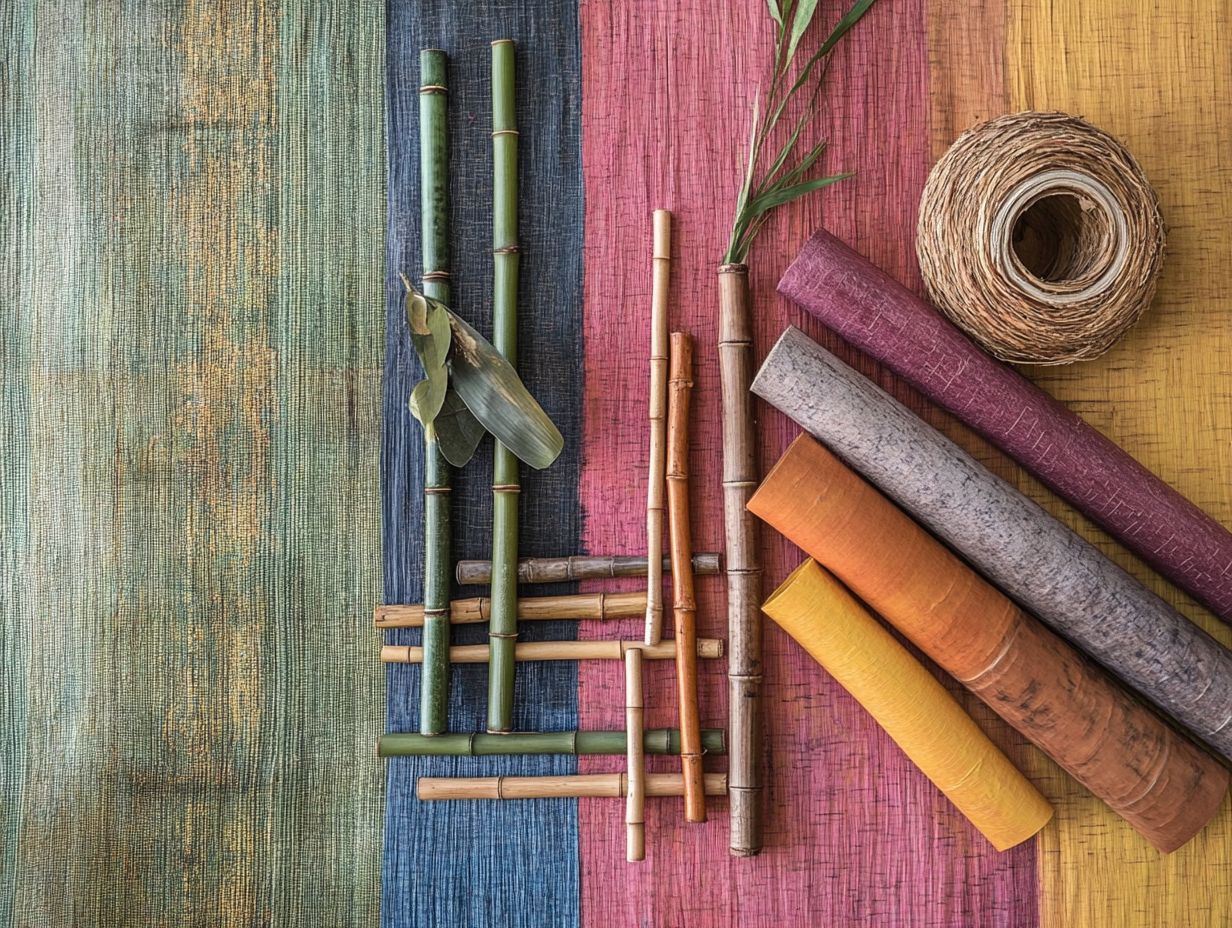Top 5 Benefits of Using Sustainable Materials
In a world increasingly focused on environmental sustainability, the materials you choose in your everyday life are more important than ever.
Opting for sustainable materials not only helps you reduce your carbon footprint but also cultivates healthier living spaces and supports local communities.
This article delves into the top five benefits of embracing sustainable materials, highlighting everything from long-term cost savings to enhanced well-being.
You’ll also learn how to seamlessly incorporate these materials into your life, explore the various types available, and understand their applications in design and construction, along with the potential challenges and risks you might encounter.
Learn how your thoughtful choices can create a brighter, sustainable future!
Contents
- Key Takeaways:
- 1. Better for the Environment
- 2. Reduces Carbon Footprint
- 3. Promotes Healthier Living Spaces
- 4. Saves Money in the Long Run
- 5. Supports Local Communities
- How Can One Incorporate Sustainable Materials into Their Daily Life?
- What Are the Different Types of Sustainable Materials?
- How Can Sustainable Materials Be Used in Construction and Design?
- What Are the Challenges in Implementing Sustainable Materials?
- What Are the Potential Risks of Using Sustainable Materials?
- Unlock the Power of Sustainable Materials for Your Business!
- Frequently Asked Questions
- What are the top 5 benefits of using sustainable materials?
- How do sustainable materials benefit the environment?
- Are there any financial benefits to using sustainable materials?
- How do sustainable materials contribute to a healthier living environment?
- Can using sustainable materials have a positive social impact?
- Are there any specific industries that can benefit from using sustainable materials?
Key Takeaways:

- Sustainable materials are better for the environment, as they are made from renewable resources and have a smaller impact on the planet’s resources.
- Using sustainable materials reduces carbon footprint, helping to combat climate change and preserve the Earth for future generations.
- Incorporating sustainable materials in daily life promotes healthier living spaces, free from harmful toxins found in traditional materials.
1. Better for the Environment
Sustainable materials are crucial for reducing your environmental impact, as they help maintain a healthy ecosystem and save resources. This paves the way for a healthier planet for future generations.
By embracing eco-friendly options like bamboo, recycled metals, and natural fibers, you can significantly lower pollution levels and move towards a circular economy, an economic system that focuses on reusing resources instead of wasting them. This approach aligns with ethical standards and adheres to guidelines from respected organizations like the Environmental Protection Agency, which highlights the importance of making environmentally responsible choices in everyday life.
Research reveals that using bamboo, for example, can cut carbon emissions by up to 35% compared to traditional timber, as documented in the Journal of Cleaner Production.
Recycling metals can lead to a staggering 75% reduction in energy consumption, illustrating a clear pathway to minimizing waste and conserving natural resources.
By adopting sustainable practices, you and industries alike can play a pivotal role in combating climate change and nurturing biodiversity, ensuring a thriving ecosystem for both current and future populations.
The cumulative impact of these practices can drive significant progress in global sustainability efforts, ultimately benefiting everyone and enhancing overall environmental resilience.
2. Reduces Carbon Footprint
The use of sustainable materials plays a crucial role in reducing the carbon footprint across various industries, especially in construction and manufacturing.
By embracing innovative materials like bamboo and recycled components, these sectors enhance energy efficiency while also lowering greenhouse gas emissions.
Take the construction industry, for example. It has increasingly turned to bamboo, a fast-growing plant that sequesters carbon as it thrives, making it an exceptional alternative to traditional timber.
In the manufacturing realm, companies are harnessing recycled plastics and metals, which require significantly less energy to process compared to their raw counterparts.
By adopting these materials, industries are not only cutting down on waste and energy consumption but also making meaningful contributions to a healthier planet.
3. Promotes Healthier Living Spaces
Sustainable materials are essential for fostering healthier living spaces and improving indoor air quality. They help minimize chemical exposure from traditional building materials.
By choosing environmentally friendly options like bamboo or recycled wood, you create a more harmonious home environment that enhances your overall well-being. Research from Harvard University shows that better indoor air quality can improve respiratory health and boost cognitive function.
Studies from SUNY Upstate Medical University show that using low-emission materials can reduce the risk of allergies and asthma symptoms. This strongly supports the adoption of sustainable practices.
Prioritizing sustainable materials transforms your space and boosts your health! You re not just creating visually appealing areas; you re also enjoying real health benefits that promote a balanced lifestyle.
4. Saves Money in the Long Run

Investing in sustainable materials leads to significant financial advantages over time. These materials are often cost-effective, energy-efficient, and designed for durability, which ultimately lowers your maintenance costs.
Although the initial investment in sustainable options may be higher, it s essential to evaluate the lifecycle costs of traditional materials. For instance, a commercial building using recycled steel and energy-efficient windows can significantly reduce utility bills, often recovering that initial investment within a few years.
The Bullitt Center in Seattle exemplifies this; it achieves net-zero energy use and shows how sustainable practices can lower operational expenses while attracting tenants willing to pay a premium for eco-friendly spaces.
In conclusion, the long-term savings, along with potential tax incentives, make embracing sustainability a financially sound strategy.
5. Supports Local Communities
Using sustainable materials is a powerful way to support local communities. It promotes ethical standards and creates job opportunities in your area. This approach enhances community impact and boosts job satisfaction among residents.
Consider initiatives like the Green Jobs Program in California, which successfully equips local residents with skills in sustainable construction practices. This leads to increased employment and the growth of eco-friendly housing. The Slow Food movement also connects local farmers to consumers, strengthening community ties and promoting regionally sourced produce.
These efforts do more than just help local economies; they also encourage responsible consumption patterns. This ensures the benefits of sustainable practices extend beyond the immediate, weaving a stronger fabric within the community.
How Can One Incorporate Sustainable Materials into Their Daily Life?
Incorporating sustainable materials into your daily life can be a transformative experience. It enhances your health and well-being while supporting sustainability initiatives, leading to an improved lifestyle.
By thoughtfully selecting items made from natural fibers, recycled resources, or biodegradable options, you can create a living space that reflects your values and fosters harmony. Whether you choose organic cotton curtains, use recycled paper for packaging, or opt for bamboo-based personal care products, these small changes can significantly impact the environment and your health.
Encouraging creativity is equally important. Experimenting with DIY projects using reclaimed materials adds unique flair to your home decor and brings joy to the creation process. This journey toward sustainability cultivates mindfulness about consumption and inspires those around you to consider eco-friendly alternatives in their everyday choices.
Start making sustainable choices today and be part of the change!
What Are the Different Types of Sustainable Materials?
Sustainable materials are a treasure trove of eco-friendly options. From bamboo to recycled materials and natural fibers, each one plays its part in sustainable practices and environmental stewardship.
Materials like hemp, cork, and biodegradable plastics are essential players in the quest for a greener future. For instance, bamboo is not just fast-growing and renewable; it is impressively strong, making it perfect for flooring and furniture.
Recycled materials work wonders, turning waste into new products. They help alleviate landfill overflow while conserving valuable resources. Natural fibers like organic cotton and wool provide breathable, biodegradable alternatives for clothing and textiles, supporting a circular economy.
By embracing these innovative solutions, you can cater to the demands of eco-conscious consumers and propel industries toward sustainable practices.
How Can Sustainable Materials Be Used in Construction and Design?

Sustainable materials can be your best allies in construction and design. They enable you to create green buildings that focus on energy efficiency, waste reduction, and why sustainable materials matter in home design with innovative solutions.
Consider incorporating reclaimed wood, recycled metal, and low-VOC paints these materials elevate your project and create a healthier environment!
Take inspiration from The Bullitt Center in Seattle, often hailed as the greenest commercial building in the world. It features composting toilets and rainwater harvesting systems. Or look to the Bosco Verticale in Milan, which shows how vertical gardens enhance air quality and aesthetics, blending nature into urban landscapes.
What Are the Challenges in Implementing Sustainable Materials?
Implementing sustainable materials can present challenges, including initial costs and industry adaptation. These factors may slow down widespread adoption despite their undeniable benefits.
Many companies wrestle with the high upfront investment typically required for sourcing and integrating eco-friendly alternatives. The availability of these materials can often be inconsistent, making it tough for manufacturers to depend on them as a reliable resource.
Industries are seeking innovative solutions, such as forging partnerships with sustainable suppliers and investing in research and development to improve material efficiency. Government policies and incentives are also emerging, encouraging companies to make the transition by offering financial support and facilitating access to sustainable technologies.
These collaborative efforts aim to dismantle barriers and accelerate the shift toward more responsible production practices.
What Are the Potential Risks of Using Sustainable Materials?
While sustainable materials offer many benefits, it’s important to acknowledge potential risks related to health outcomes, chemical exposure, and worker safety. These require careful management.
As you seek eco-friendly options, remember that not all sustainable materials are created equal. Some products may come from manufacturers who prioritize cost-cutting over rigorous testing and ethical practices.
This can lead to concerns such as off-gassing harmful chemicals or relying on labor that falls short of safety standards. Ensuring that suppliers maintain stringent quality control measures and ethical sourcing practices is essential.
By taking these steps, you can effectively mitigate these risks, creating a safer environment for both workers and consumers while enjoying significant environmental benefits.
Unlock the Power of Sustainable Materials for Your Business!
Embracing sustainable materials unlocks significant benefits. These include financial gains, a stronger brand reputation, and a positive community impact.
With rising consumer demand for eco-friendly products, industries like fashion and construction can stand out. A leading apparel brand saw a boost in customer loyalty and sales by incorporating organic cotton and recycled polyester.
A packaging company that switched to biodegradable materials cut production costs. This attracted eco-conscious clients and opened doors to new partnerships.
These examples show that integrating sustainable materials drives innovation and positions businesses as sustainability champions.
Frequently Asked Questions

What are the top 5 benefits of using sustainable materials?
1. Reduced environmental impact: Using sustainable materials helps minimize pollution, deforestation, and greenhouse gas emissions, making choosing sustainable materials a smart move.
2. Conservation of natural resources: These materials are often made from renewable resources, aiding in the conservation of our natural resources for future generations.
3. Cost savings: While the initial cost may be higher, choosing local sustainable materials can save money long-term through reduced energy and maintenance expenses.
4. Healthier living spaces: They are often free from harmful chemicals and toxins, creating a healthier environment for both people and animals.
5. Positive social impact: Utilizing sustainable materials supports fair labor practices and benefits local communities, promoting social and economic sustainability.
How do sustainable materials benefit the environment?
Sustainable materials lower our carbon footprint and protect natural resources. They help preserve biodiversity and minimize the negative effects of human activities.
Are there any financial benefits to using sustainable materials?
Yes! While the initial cost may be higher, these materials can lead to long-term savings through reduced energy and maintenance costs. They can also attract environmentally-conscious customers, driving business growth and revenue.
How do sustainable materials contribute to a healthier living environment?
Sustainable materials are frequently free from harmful chemicals and toxins that can affect human health. Utilizing these materials fosters healthier living spaces, promoting overall well-being and reducing health risks associated with toxin exposure.
Absolutely! Sustainable materials support fair labor practices and positively impact local communities. This effort promotes social and economic sustainability, helping create a more equitable society.
Are there any specific industries that can benefit from using sustainable materials?
Yes, industries such as construction, fashion, and manufacturing can significantly benefit from sustainable materials. This approach reduces environmental impact, enhances brand image, and attracts eco-conscious customers.






